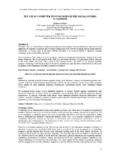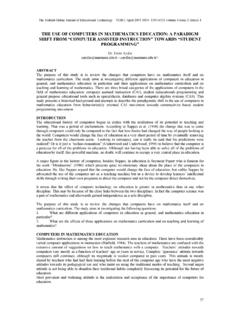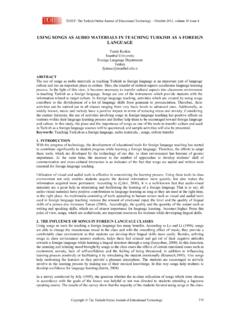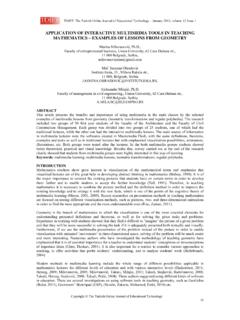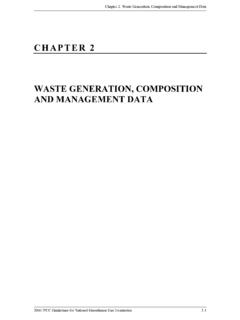Transcription of THE IMPACT OF ICT ON EDUCATIONAL PERFORMANCE AND …
1 TOJET: The Turkish Online Journal of EDUCATIONAL Technology July 2012, volume 11 Issue 3 Copyright The Turkish Online Journal of EDUCATIONAL Technology 144 THE IMPACT OF ICT ON EDUCATIONAL PERFORMANCE AND ITS EFFICIENCY IN SELECTED EU AND OECD COUNTRIES: A NON-PARAMETRIC ANALYSIS Aleksander Aristovnik University of Ljubljana, Slovenia ABSTRACT The purpose of the paper is to review some previous researches examining ICT efficiency and the IMPACT of ICT on EDUCATIONAL output/outcome as well as different conceptual and methodological issues related to PERFORMANCE measurement. Moreover, a definition, measurements and the empirical application of a model measuring the efficiency of ICT use and its IMPACT at national levels will be considered.
2 For this purpose, the Data Envelopment Analysis (DEA) technique is presented and then applied to selected EU-27 and OECD countries. The empirical results show that the efficiency of ICT, when taking EDUCATIONAL outputs/outcomes into consideration, differs significantly across the great majority of EU and OECD countries. The analysis of the varying levels of (output-oriented) efficiency (under the VRSTE framework) shows that Finland, Norway, Belgium and Korea are the most efficient countries in terms of their ICT sectors. Finally, the analysis finds evidence that most of the countries under consideration hold great potential for increased efficiency in ICT and for improving their EDUCATIONAL outputs and outcomes.
3 Keywords: Information and Communication Technology (ICT), education, PERFORMANCE , efficiency, DEA, EU, OECD INTRODUCTION Information and communication technology (ICT) is one of the most important driving forces promoting economic growth in the economy. However, there is less of a consensus among economists on whether the IMPACT of ICT also stems from higher total factor productivity (TFP) growth and improved efficiency of production (due to a better educated population). During the last two decades countries have invested heavily in ICT. Indeed, the use of ICT in education and training has been a key priority in most EU and OECD countries in the last decade, although progress has been uneven.
4 ICT has had a major IMPACT on the education sector, on organisation and on teaching and learning methods. Yet there are considerably different ICT expenditure levels within and between countries, as well as between institutions within countries. In some countries schools have embedded ICT into the curriculum, and demonstrate high levels of effective and appropriate ICT use to support teaching and learning across a wide range of subject areas. However, in other countries schools are in the early phase of adopting ICT, characterised by important enhancements of the learning process, some developments of e-learning (ICT-enabled learning), but without any profound improvements in learning and teaching (Balanskat et al.)
5 , 2006). One puzzling question concerns the effective IMPACT of these technologies on EDUCATIONAL outputs and outcomes. As ICTs are being increasingly used in education, indicators to monitor their IMPACT and demonstrate accountability to funding sources and the public are ever more needed. Indicators are required to show the relationships between technology use and EDUCATIONAL PERFORMANCE . There is also a need to show that education should be seen as using technology not only as an end in itself, but as a means to promote creativity, empowerment and equality and produce efficient learners and problem solvers.
6 Many academic researchers have tried to answer this question at theoretical and empirical levels. They have faced two main difficulties. On one hand, student PERFORMANCE is hard to observe and there is still confusion about its definition. On the other, ICT entails evolving technologies and their effects are difficult to isolate from their environment. Consequently, the relationship between the use of ICT and EDUCATIONAL PERFORMANCE is unclear, and contradictory results are presented in the literature (Youssef and Dahmani, 2008). Accordingly, the paper s purpose is to discuss and review some previous researches on ICT efficiency and ICT s IMPACT on EDUCATIONAL outcomes as well as different conceptual and methodological issues related to measuring PERFORMANCE in education.
7 Moreover, a definition, measurements and an empirical application of a model measuring the efficiency of ICT at national levels will be considered, with a special focus on EDUCATIONAL variables as outputs/outcomes. In this context, the Data Envelopment Analysis (DEA) technique will be presented and then applied to selected EU-27 and OECD countries. The paper is structured as follows: first, a brief survey of the literature relating to ICTs and their IMPACT on education PERFORMANCE is presented, then the methodology is established and the specifications of the models are defined.
8 The next section outlines the results of the non-parametric efficiency analysis and presents partial TOJET: The Turkish Online Journal of EDUCATIONAL Technology July 2012, volume 11 Issue 3 Copyright The Turkish Online Journal of EDUCATIONAL Technology 145 correlation coefficients in order to assess the IMPACT of ICT on EDUCATIONAL PERFORMANCE . The final section provides concluding remarks and some policy implications. LITERATURE REVIEW Many theoretical and empirical efforts have been made to assess the IMPACT of ICT on in EDUCATIONAL PERFORMANCE in various settings.
9 Recent approaches to evaluating ICT in education often only focus on a few aspects such as input, output and outcome/ IMPACT . The use of indicators can help assess how the input ( monetary, infrastructure, resources) relates to the IMPACT . However, an evaluation must consider different stages in the implementation process and analyse changes in the culture of the school system at the micro level (pupils) as well as at the meso (institutions/schools) and macro (national) levels. At national and institutional levels, EDUCATIONAL policies and regulations have been established to support the EDUCATIONAL use of ICT.
10 In school and classroom settings, teachers and school administrators are attempting to find the best ways to harness ICT technology to support their teaching and students success. However, accomplishments that are convincingly the result of the direct causal IMPACT of ICT use are not always easily identifiable (Kang et al., 2008). Currently, there is a significant number of initiatives to assess and monitor the efficiency of ICT use and its IMPACT on education. SITES (the second information technology in EDUCATIONAL study), sponsored by the International Association for the Evaluation of EDUCATIONAL Achievement (IEA), is an exemplary study which identifies and describes the EDUCATIONAL use of ICT across 26 countries in the world.
